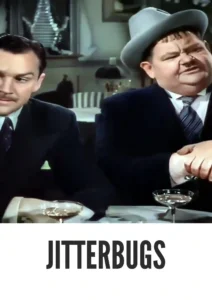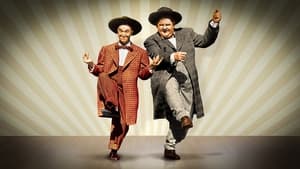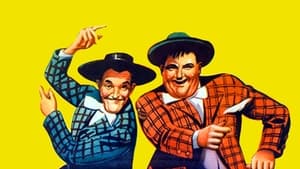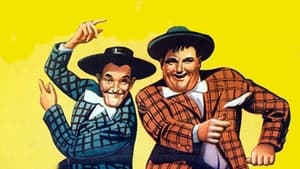Contact: info@alwanfilm.com
Video Sources 0 Views

Jitterbugs 1943 Colorized
Synopsis
Review: Jitterbugs 1943 Colorized – A Classic Comedy Gem

Introduction
“Jitterbugs 1943,” a delightful film from the golden age of Hollywood, stars the legendary comedic duo Laurel and Hardy. Directed by Mal St. Clair, this film is a testament to the enduring appeal of slapstick comedy and the charm of its iconic stars. In this article, we will delve into the world of “Jitterbugs 1943,” examining its plot, characters, and the unique elements that make it a timeless classic. We will also discuss the significance of its release during World War II and its impact on audiences then and now.
Check The Full Colorized Movies List
Check Our Colorized Movies Trailer Channel
Understanding Jitterbugs 1943: Director, Cast, and Genre
“Jitterbugs 1943” is helmed by director Mal St. Clair, a veteran of the comedy genre known for his ability to craft lighthearted, engaging narratives. The film stars Stan Laurel and Oliver Hardy, whose chemistry and comedic timing had already established them as beloved figures in the world of cinema. Their performances in “Jitterbugs” are no exception, bringing a perfect blend of humor and heart to the screen.
Laurel and Hardy play con artists who, while on the run, stumble upon a scheme involving fake musical instruments and a big con in a small town. The film falls squarely into the comedy genre, with elements of musical comedy interwoven to enhance its appeal. The presence of jitterbugging—a popular dance style of the era—adds a vibrant energy to the film, making it a lively and entertaining watch.
Exploring the World of Jitterbugs 1943: Plot and Characters
“Jitterbugs 1943” follows the adventures of Stan and Ollie, two hapless musicians who find themselves entangled in a series of comedic misadventures. The plot kicks off with the duo traveling across the country in a dilapidated car, performing their music act to make ends meet. Their journey takes a turn when they encounter Chester Wright, played by Bob Bailey, a smooth-talking conman with a dubious plan.
Chester convinces Stan and Ollie to help him sell “gasoline pills,” which he claims can turn water into gasoline. The trio sets up shop in a small town, where they attract the attention of local businessman Malcolm Bennett, played by Douglas Fowley. Bennett is also running a scam, and the stage is set for a hilarious clash of con artists.
The film’s characters are richly drawn, each contributing to the overall comedic tapestry. Stan and Ollie’s bumbling yet endearing personas are complemented by Chester’s slick charm and Bennett’s devious schemes. The film also features the spirited singer-dancer, Gloria, played by Vivian Blaine, who adds a touch of romance and musical flair to the story.
The Art of Comedy in Jitterbugs 1943
The comedy in “Jitterbugs 1943” is classic slapstick, characterized by physical humor, pratfalls, and misunderstandings. Laurel and Hardy’s impeccable timing and expressive faces make even the simplest of scenes uproariously funny. Their ability to convey a range of emotions—confusion, frustration, joy—through physicality is a testament to their talent and a key reason for their enduring popularity.
One of the film’s standout sequences involves a jitterbug dance contest, where Stan and Ollie inadvertently enter and must navigate the energetic and unpredictable dance moves. This scene showcases their physical comedy prowess and highlights the film’s musical elements, blending laughter with the rhythmic beats of the jitterbug.
The Historical Context of Jitterbugs 1943
Released in 1943, “Jitterbugs” came at a time when the world was engulfed in the turmoil of World War II. Hollywood films during this era often provided much-needed escapism for audiences, offering a respite from the harsh realities of war. “Jitterbugs” is no exception, with its lighthearted plot and comedic antics serving as a balm for viewers seeking laughter and joy.
The film’s title, “Jitterbugs,” references the popular dance craze of the time, reflecting the cultural zeitgeist. Jitterbugging was not only a dance but a symbol of youthful exuberance and defiance, resonating with audiences eager for moments of levity amidst the uncertainty of wartime.
The Debate Over Comedy in Wartime
The role of comedy during times of conflict has always been a subject of debate. Some argue that humor is essential for morale, providing a necessary outlet for stress and anxiety. Others contend that it can be seen as trivializing serious issues. “Jitterbugs 1943” strikes a balance, offering humor that is light and uncontroversial, allowing audiences to enjoy a moment of respite without detracting from the gravity of the era.
Laurel and Hardy’s brand of comedy—innocent, physical, and universally relatable—transcends the specifics of its time, making it accessible to audiences then and now. Their antics are rooted in human nature, highlighting the absurdities of life in a way that resonates regardless of the surrounding circumstances.
Examining Jitterbugs 1943 as a Product of Its Time
Viewing “Jitterbugs 1943” through the lens of its historical context enriches our understanding of its themes and significance. The film captures the spirit of resilience and optimism that characterized the American home front during World War II. Despite the hardships and uncertainties, there was a collective determination to find joy and humor in everyday life.
The inclusion of musical elements and dance numbers further underscores this theme. Music and dance were powerful forms of expression and escapism during the war, offering moments of happiness and community. “Jitterbugs” taps into this cultural current, using its musical comedy framework to deliver entertainment that is both uplifting and enduring.
Influence and Legacy: Jitterbugs 1943’s Impact on Cinema
“Jitterbugs 1943” stands as a testament to the timeless appeal of Laurel and Hardy’s comedy. Their influence on the genre is profound, with echoes of their style seen in the works of later comedic duos and ensembles. The film’s blend of slapstick, music, and dance has inspired countless productions, demonstrating the versatility and enduring charm of this approach.
The film also holds a special place in the legacy of wartime cinema, representing the power of humor and entertainment to uplift spirits during challenging times. Its success contributed to the ongoing popularity of musical comedies and solidified Laurel and Hardy’s status as icons of the genre.
Director’s Cinematic Legacy: Beyond Jitterbugs 1943
Mal St. Clair, the director of “Jitterbugs 1943,” had a prolific career in Hollywood, contributing to a variety of genres beyond comedy. His work in the silent film era and transition to talkies showcases his adaptability and skill as a filmmaker. St. Clair’s ability to elicit strong performances and create engaging narratives is evident in “Jitterbugs” and his broader filmography.
While “Jitterbugs” is a standout in his career, St. Clair’s influence extends to his contributions to early Hollywood cinema, shaping the comedic landscape and collaborating with some of the industry’s most beloved stars. His legacy is a testament to the enduring power of well-crafted comedy and the impact of filmmakers who understand the nuances of humor and storytelling.
Themes Explored in Jitterbugs 1943
“Jitterbugs 1943” explores themes of deception, resilience, and the quest for happiness amidst adversity. The film’s central plot revolves around cons and scams, highlighting the lengths to which individuals will go to survive and succeed. Yet, despite the deception, there is an underlying innocence to the characters’ schemes, driven more by desperation than malice.
The theme of resilience is embodied by Stan and Ollie, whose unwavering optimism and camaraderie carry them through their misadventures. Their ability to find joy and laughter in the face of challenges is a reflection of the human spirit’s capacity for hope and perseverance.
Reception and Controversy Surrounding Jitterbugs 1943
Upon its release, “Jitterbugs 1943” was met with positive reviews from critics and audiences alike. The film’s humor, musical elements, and the beloved presence of Laurel and Hardy resonated with viewers, providing a much-needed escape during wartime. However, as with any piece of art, it was not without its detractors.
Some critics argued that the film’s lighthearted approach was at odds with the seriousness of the times, suggesting that it trivialized the harsh realities faced by many. However, the overwhelming consensus was that “Jitterbugs” succeeded in offering a welcome respite and a reminder of the importance of laughter and joy.
Where to Watch Jitterbugs 1943 Online
For those eager to experience the charm and humor of “Jitterbugs 1943,” the film is available on various streaming platforms. Classic film enthusiasts can find it on services dedicated to vintage cinema, ensuring that new generations can appreciate the timeless comedy of Laurel and Hardy.
FAQs About Jitterbugs 1943
Common queries surrounding “Jitterbugs 1943” often pertain to its historical context, the legacy of its stars, and its place in the broader landscape of comedy cinema. Here, we address some frequently asked questions to provide deeper insight into the film and its enduring appeal.
Q: Who were Laurel and Hardy?
A: Stan Laurel and Oliver Hardy were a comedic duo whose partnership began in the 1920s and continued until the early 1950s. Known for their slapstick humor and impeccable timing, they became one of the most beloved comedy teams in film history.
Q: What is jitterbugging?
A: Jitterbugging is a style of dance that became popular in the 1930s and 1940s, characterized by energetic, acrobatic movements. It was often performed to swing music and became a cultural phenomenon during the era.
Q: How does “Jitterbugs 1943” reflect its historical context?
A: “Jitterbugs 1943” captures the spirit of resilience and optimism during World War II, offering humor and entertainment as a form of escapism. Its themes of deception and resilience resonate with the experiences of many during the tumultuous period.
Conclusion
“Jitterbugs 1943” remains a shining example of the timeless appeal of Laurel and Hardy’s comedy. Directed by Mal St. Clair, the film combines slapstick humor, musical elements, and a vibrant portrayal of the jitterbug dance craze to create a delightful cinematic experience. Its release during World War II underscores the importance of humor and escapism in challenging times, offering audiences a much-needed respite from the harsh realities of the era.
As we reflect on the enduring legacy of “Jitterbugs 1943,” we are reminded of the power of laughter to uplift spirits and bring people together. Whether experienced in its original theatrical release or through modern streaming platforms, the film continues to enchant and entertain, a testament to the enduring brilliance of Laurel and Hardy and the timeless charm of classic Hollywood cinema.













